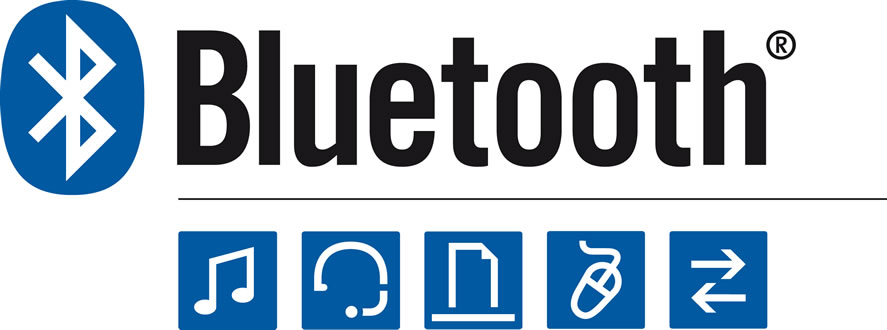Basic Info on Bluetooth

Introduction:
Bluetooth is a big tooth which is Blue.

We all thought it could be that when we first heard the name. What would be Bluetooth ?
Here we get to know some basic infor on Bluetooth. Read on.....
So, Why is it named Bluetooth ?
The name Bluetooth comes from the 10th century Danish King Harald Blåtand or Harold Bluetooth in English. King Blåtand helped unite warring factions in parts of what are now Norway, Sweden and Denmark. Similarly, Bluetooth technology was created as an open standard to allow connectivity and collaboration between disparate products and industries.
Logo:
The Bluetooth logo is a bind rune merging the Younger Futhark runes  (Hagall) (ᚼ) and
(Hagall) (ᚼ) and  (Bjarkan) (ᛒ), Harald's initials
(Bjarkan) (ᛒ), Harald's initials

Bluetooth is a wireless technology standard for exchanging data over short distances (2.4 to 2.485 GHz garage open doors and baby monitors also operate in the same range) from fixed and mobile devices, and buildingpersonal area networks (PANs).It was invented by Ericsson in 1994. Just like WiFi, cell phones and car radios, Bluetooth uses radio waves to communicate. Bluetooth speakers don't make your cell phone ring because these devices use different radio frequencies.
It was originally conceived as a wireless alternative to RS-232 data cables. It can connect several devices, from light bulbs to headsets and everything in between.
Range
Bluetooth has a typical range of about 10 meters. Some even have a range of about 100m!.
The short range of Bluetooth signals make them perfect for handling communications between a phone and an earpiece or a computer and a set of speakers. This also cuts down on the amount of required power.
Bluetooth can support up to eight simultaneous connections(1 master device and other slave devices) in a 10-meter radius. The devices don't interfere with each other because of each device in a Bluetooth network switches back and forth among 79 random frequencies. This makes it unlikely that your baby monitor, which uses the same part of the radio spectrum, will horn in on your GPS receiver.
A bluetooth device of range 100m
Fact :Bluetooth device change frequencies 1,600 times ! per second. Bluetooth transmissions are always on the move. Their constant jumping from frequency to frequency is what keeps them from disrupting each other and with non-Bluetooth devices.
Piconet:
A piconet is a network established by Bluetooth devices. Communicating Bluetooth devices establish a network known as a piconet. A piconet might be as small as the distance from your earpiece to the belt clip for your phone. Or, it may stretch from the base station in your kitchen to the cordless phone handset in your living room. If your GPS chimes in, the other devices will ignore it -- it's not part of the network.

A Bluetooth Card
Bluetooth Profiles:
A2DP (Advanced Audio Distribution Profile) makes streaming stereo music possible.
GATT (Generic Attribute Profile) allows developers to build unique profiles specific for their applications (Bluetooth fork, anyone?).
HID (Human Interface Device Profile) makes your Bluetooth enabled mice and keyboards work effortlessly.
BIP (Basic Imaging Profile) allows you to send images between devices (other phones, printers, even picture frames).
Bluetooth Versions:
Bluetooth v4.2 was released on December 2, 2014. It Introduces some key features for IoT (Internet of Things). Some features, such as Data Length Extension, require a hardware update. But some older Bluetooth hardware may receive some Bluetooth v4.2 features, such as privacy updates via firmware.
The major areas of improvement are:
- LE Data Packet Length Extension
- LE Secure Connections
- Link Layer Privacy
- Link Layer Extended Scanner Filter Policies
- IP connectivity for Bluetooth Smart devices to become available soon after the introduction of BT v4.2 via the new Internet Protocol Support Profile (IPSP).
- IPSP adds an IPv6 connection option for Bluetooth Smart, to support connected home and other IoT implementations.
Read more about it here https://en.wikipedia.org/wiki/Bluetooth
Bluetooth vs WiFi:
Bluetooth and Wi-Fi have some similar applications: setting up networks, printing, or transferring files. Wi-Fi is intended as a replacement for high speed cabling for general local area network access in work areas. This category of applications is sometimes called wireless local area networks (WLAN). Bluetooth was intended for portable equipment and its applications. Bluetooth is a replacement for cabling in a variety of personally carried applications in any setting, and also works for fixed location applications such as smart energy functionality in the home (thermostats, etc.).
Wi-Fi and Bluetooth are to some extent complementary in their applications and usage. Wi-Fi is usually access point-centered, with an asymmetrical client-server connection with all traffic routed through the access point, while Bluetooth is usually symmetrical, between two Bluetooth devices. Bluetooth serves well in simple applications where two devices need to connect with minimal configuration like a button press, as in headsets and remote controls, while Wi-Fi suits better in applications where some degree of client configuration is possible and high speeds are required, especially for network access through an access node. However, Bluetooth access points do exist and ad-hoc connections are possible with Wi-Fi though not as simply as with Bluetooth. Wi-Fi Direct was recently developed to add a more Bluetooth-like ad-hoc functionality to Wi-Fi.


0 comments: